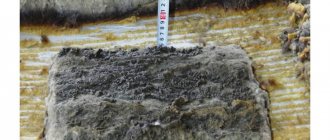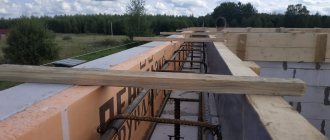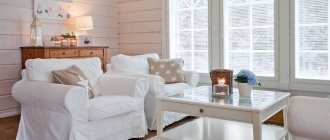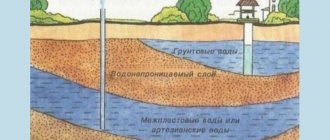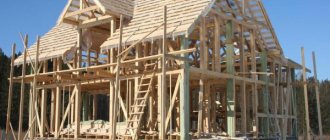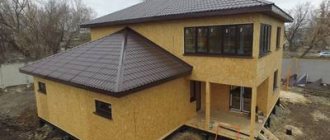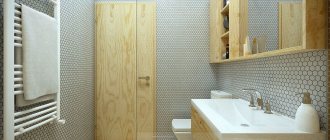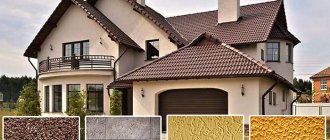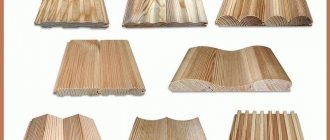One of the most important concepts in construction is dew point. At the stage of wall insulation, this allows you to correctly select the type and thickness of the heat-insulating material and create an optimal microclimate inside the building. There are several ways to determine the dew point. However, you also need to know what to do with the results obtained.
What is dew point
The dew point is a certain limit of air temperature, below which the vapor contained in the air becomes saturated and turns into liquid.
The dew point is the place where cold air meets warm air, and the place where their interaction forms liquid in the form of condensation. Using the example of building structures, the dew point appears in the form of condensation on the windows. Always, when it gets cold outside, we see fogging and water droplets forming on previously dry window panes. This is the closest and most harmless manifestation of the dew point.
condensation on the window
In nature, the dew point appears in the form of drops of morning dew on plant leaves and other objects. It is formed as a result of the interaction of cold night air and warm morning air heated by the sun's rays.
manifestation of dew point condensation in nature
In the case of heated premises, the dew point is created artificially at any time of the day, under conditions of temperature below zero outside.
It is a completely different matter if the formation of such dew point condensation is detected on the inside of the wall of the house. Even a not very experienced builder will be concerned about the formation of excess liquid in a previously dry room. Since the consequences of such accumulations of moisture can be the most unfavorable. But the interior wall of a house is not the only destructive place where incorrect calculation of the dew point or its absence can manifest itself.
Incorrect calculation and location of the dew point for a home is the number one destructive enemy in construction. Which, from the inside, slowly but surely destroys any strong structure.
Areas of application
There are many areas that take this temperature into account. One of the areas is aviation. During aircraft operation, condensation may form on some of its parts and freeze. This leads to freezing of the engine, metal structures of the flying vehicle and its breakdown.
In forestry, fire conservationists use dew point to calculate fire hazard class.
Experts calculate the likelihood of forest fires and develop protective measures.
Most often, determining the point is necessary in construction and agriculture.
Video: Dew point - insulating the house wisely
Construction
In construction, this value is determined when insulating the facades of buildings and private buildings. If you do not take into account the indicator or calculate it incorrectly, due to settling moisture, the wall finishing material will deteriorate or pathogenic flora and mold will appear.
Agriculture
In agriculture, experts determine the likelihood of damage to crops due to weather conditions, knowing the point and atmospheric humidity.
When cultivating new plants, breeders try to create varieties that condense moisture on the vegetative parts. Such plantings can exist with little precipitation.
Where should the dew point be?
The ideal place for the dew point to occur in a wall is the insulation located on the outside of the wall. The thickness of the insulation on the wall should be such that in the coldest time condensation does not move into the wall itself, or if it does, it will not be for a long time.
dew point in insulation
For the destructive consequences of the dew point being in the body of a load-bearing wall, see the article below.
Walls based on porous materials, such as foam and gas blocks, shell rock and similar materials, require a larger layer of insulation, since they absorb and retain moisture well. That is, even a short-term (several days) presence of dew point in a porous wall can have a destructive effect on the internal integrity. Therefore, so-called warm materials for masonry walls can only be effective in certain regions, with not the most frosty winters.
If, according to calculations, the dew point will periodically move into the wall of the house itself or there is a high probability of such a shift, then this fact should be taken into account when choosing material for laying walls. For such cases, wall materials with high density are well suited and can withstand a large number of freezing and thawing cycles without damage. With a high frost resistance coefficient. Such frost-resistant materials include brick and expanded clay concrete.
frost resistance indicators of the most common wall materials
Toilet finishing options: finishing with tiles, wallpaper, panels, photos
The decoration of the toilet should not only be beautiful, but also practical. It is advisable to choose decorative coatings that do not absorb odors and are easy to clean. The most popular are wall panels, tiles and, oddly enough, wallpaper.
Plastic panels are an economical and convenient way to decorate a toilet with your own hands. The cost of one square meter does not exceed $7, and the richness of the color palette is also pleasing. The consumer today is free to choose between classic plain panels, bright samples with abstract patterns and designs, as well as sheets that imitate one or another texture (marble, wood, malachite, etc.). The length of one PVC sheet is 2.5-3 meters, this is enough to cover the entire length of the wall.
Finishing the toilet with plastic panels is possible not only on the walls, but also on the ceiling. True, unlike PVC wall sheets, the width of which is usually 30 cm, for finishing the ceiling it is better to use plastic about 20 cm wide. In this case, the decorative coating will look more harmonious and neat.
Ceramic tiles are a classic of the genre. Materials of different sizes are suitable for tiling a toilet. As a rule, rectangular elements measuring 20x30 cm are laid on the walls. In order to visually expand the interior space of the restroom, it is recommended to choose tiles coated with a glossy glaze.
The tiles on the floor also feel good. However, in this case, tiling the toilet is best done using a material with a matte surface. The rough coating will protect you from falls and injuries.
Wallpaper for the toilet is a rare but possible finishing option
When choosing wallpaper, pay attention to its properties. It is desirable that the canvas be moisture resistant and have an oilcloth surface. Vinyl wallpaper is also suitable
The latest fashion hit is the so-called liquid wallpaper in the toilet, photos of which can be viewed in our gallery
Vinyl wallpaper is also suitable. The latest fashion hit is the so-called liquid wallpaper in the toilet, photos of which can be viewed in our gallery.
Dew point calculation online calculator
There are many online programs on the Internet - calculators, with which you can calculate the approximate location of the dew point in the wall. The program calculates the dew point based on a number of indicators that must be entered manually. This is information about the material from which it is planned to build the wall, the number of layers of the wall and their thickness, the air temperature inside and outside the building, air humidity. The online calculator is convenient for calculations. Together with digital calculations, you can see diagrams and graphs of the dew point movement depending on changes in air temperature. However, the calculation results for many calculators differ and how accurate the calculations are is unknown.
online calculator for determining dew point
Comfortable values for a person
For most people, conditions with a point value in the range of +10…+15℃ are optimal. If the indicator increases, then the person feels discomfort. When the point value is less than +10℃, the environment becomes dry, and from +15℃ humidity begins to be felt. If the indicator is above +20℃, it becomes stuffy. People with heart and respiratory problems are more susceptible to environmental parameters than others.
The dew point temperature determines the comfort level of living in the house
Calculation of dew point using the device
The dew point can also be determined in real time using a special TV. This is an electronic device with a monitor that will display information about indoor humidity, air temperature and dew point. Such devices are relevant for measuring the dew point for an already erected and completed building structure. This device will not help in designing the thickness of walls and buildings.
dew point thermal imager
Thermal insulation material
To protect buildings from heat loss, high humidity and point shifts, it is insulated with thermal insulation materials. In winter, insulation helps reduce heating costs, and in summer it keeps the room cool. Each product has its own areas of application and properties. Eco-friendly and easy-to-install materials are used in construction. The required type of insulation is selected for certain conditions.
With proper insulation from the outside, the dew point will be located inside the insulation
According to their form, materials are divided into:
- roll;
- leafy;
- bulk;
- single.
By structure:
- fiber;
- cells;
- grainy.
Raw materials can be organic, inorganic and mixed.
Main characteristics of insulating materials:
- thermal conductivity;
- moisture absorption;
- porosity;
- humidity;
- density;
- vapor permeability;
- specific heat;
- strength, etc.
Penoplex
Penoplex is also called expanded polystyrene. Unlike foam polystyrene, the material has a higher density and is less subject to mechanical damage. It almost does not conduct steam due to its low vapor permeability coefficient. However, it belongs to group IV of flammability (it ignites quickly).
Penoplex is recommended for external wall insulation
Penoplex of the “comfort” category is produced for insulating walls, terraces, loggias, and balconies. Its thermal conductivity coefficient is 9 times less than that of mineral wool. The material requires little time to heat the room after cooling due to its low heat capacity. The operating temperature range is -70…+70℃. Penoplex of this type does not have the best sound insulation, has the lowest density and lower tensile strength compared to other materials.
Penoplex for walls is suitable only if an effective ventilation system is installed in the room to maintain comfortable humidity.
A 2 cm wide layer of polystyrene foam retains heat almost as well as 40 cm of mineral wool or 37 cm of brickwork.
Styrofoam
Polystyrene foam is a material characterized by lightness and buoyancy. It is resistant to fire, but when exposed to fire it begins to melt. The material is easy to process and is not subject to infection by fungi and mold.
Polystyrene foam is obtained from foamed polymer raw materials: polystyrene, polyethylene, polyvinyl chloride or polyurethane. It consists of small identical balls that are fastened together. High-density rigid foam is used for insulation. The panels are easy to connect using rubber or epoxy adhesive.
The temperature range is not important for polystyrene foam, but the material is subject to mechanical damage.
Slabs 5 and 10 cm thick are used as thermal insulation. But, despite the structure, the material is sound-permeable.
Polystyrene foam is one of the most common materials for home insulation.
Mineral wool
Thermal insulation material consists of compressed fibers. Glass, basalt and slag are used as raw materials. The starting material is melted and spun into fibers. Their length is 2-60 mm. The air pores of the mats fill approximately 95% of the total volume. The product is easy to produce and has a low cost.
Mineral wool has many qualities suitable for home insulation.
Due to its porosity, cotton wool allows air and steam to pass through, maintaining air exchange. At the same time, it does not burn and is resistant to moisture, has good sound insulation. But the material has 2 drawbacks:
- contains phenol;
- Flying pieces of cotton wool, falling on human skin, cause itching.
Damage to dew point for house walls
We figured out that the dew point can be located in three different parts of the wall:
- in external wall insulation
- in the wall, closer to the outside
- in the wall, closer to the inside
In each of the listed places, the dew point will manifest itself differently. If in one place it is harmless, then inside the house or in the wall it will have certain destructive consequences on the integrity of the wall. Below, we will analyze the behavior of the dew point in each of the listed places.
Dew point in external insulation
This is the most harmless dew point for your home. In this case:
- When the dew point occurs, condensation forms directly in the insulation itself.
- The insulation is not hygroscopic, therefore moisture is not retained in the wall structure and evaporates when the air temperature changes.
- Due to the vapor barrier properties of the insulation, the moisture that is formed when condensation evaporates goes outside and does not interact with the wall of the house.
- The walls of the house are dry throughout the year, both from the outside and from the inside
- The walls retain their strength and integrity for many decades
insulation on the outside
Dew point in the wall of the house, closer to the outside
- The behavior of a wall largely depends on the material from which it is made. Walls made of dense and heavy building materials such as brick, expanded clay concrete, stone, and wood can withstand dew point better. Because they are less susceptible to destruction and have a higher frost resistance coefficient.
- The walls of houses built from porous materials that absorb moisture well and allow steam to pass through. Such as foam blocks, gas blocks and similar materials, the effect of the dew point should be minimally short.
destruction of a wall due to moisture
- When condensation occurs inside the wall, the wall material becomes saturated with liquid. When the air temperature subsequently drops below zero, the accumulated liquid freezes and increases in volume. An increase in the volume of liquid destroys any wall material from the inside. This leads to the formation of both small and large cracks in the wall structure. The walls crumble and finally lose their strength.
- If the wall, in which the dew point is inside and is insulated from the outside, then the insulation will not prevent the accumulated moisture from escaping outside. Therefore, all the liquid will accumulate on the surface, between the insulation and the wall. This entails the formation of mold and mildew, with all the ensuing consequences that are harmful both to the building and to human health.
- If the wall of the house is not insulated from the outside, then the liquid will come out as the air temperature rises, but this will not protect the wall from internal destruction after the water freezes. We can observe similar evaporation of liquid from a damp wall in the form of a white coating on brick walls.
release of moisture from a brick wall in the form of a white coating
Dew point in the wall of the house, closer to the inner surface
It occurs when steam passes through the middle of the wall thickness and condensation begins to form closer to the surface of the wall, which is located inside the house.
Consequences of dew point for the interior decoration of the house:
- The masonry, saturated with moisture, begins to release liquid in the form of water droplets on the inner wall and into the house.
- A wet wall surface destroys the interior decoration of the room: putty, wallpaper and other finishing materials.
- Mold and mildew form on the walls and in the corners, which will be very difficult to get rid of.
- An unpleasant, shabby smell of decomposition appears in the house, which is harmful to health.
- The overall heat temperature in the house decreases.
mold on the wall inside the house
The most destructive and harmful consequences for the house is when the dew point is closer to the inner surface of the wall.
Dew point is an important parameter that should be taken into account when designing and constructing walls, roofs and the construction of the entire house. Failure to comply with it can lead to irreversible and critical consequences for the entire building.
Finally, recommendations for those who build with aerated concrete:
- The most economical, fastest to produce and most comfortable construction for external walls is made of aerated concrete blocks of density D400 (D400). In our region, such blocks are produced only under the Twinblock brand; - If you are building a house for permanent residence, - Twinblock D400 with a thickness of 400 mm is suitable for you; - If you are building a house for seasonal residence, - Twinblock D400 with a thickness of 300 mm is optimal for you;
- Aerated concrete blocks cannot be laid on regular cement mortar. Only use special glue - mineral or polyurethane. The thickness of the seams is no more than 3 mm;
- Carefully control the quality of filling of seams (especially vertical ones) to prevent “waste”;
- Do not use metal products that “pierce” a significant part of the wall thickness. For example, metal dowel-nails for attaching insulation;
- Do not use polystyrene foam (PSB) or extruded polystyrene foam (EPS) as insulation for external walls. For external walls made of aerated concrete of density D400 of sufficient thickness, insulation is not required at all;
- Use adhesives, plaster mixtures and paints with a high vapor transmission value for exterior wall finishing;
If you follow these recommendations, you can not fear the negative consequences associated with the “Dew Point”. Its appearance is a natural physical process. The main thing is to take this factor into account when choosing a wall design and follow the technology during construction!
Experts' opinion
Experts believe that the best thermal insulation option is mineral wool. If installed correctly, the material will not cause harm and will last a long time. The main thing is to avoid high humidity. To do this, the cotton wool is additionally covered with a film that limits the access of moisture.
Another option is to install breathable materials on both sides of the insulation that will release liquid to the outside. It is recommended to lay polystyrene foam or expanded polystyrene in combination with materials that do not allow water vapor to pass through and prevent moisture condensation.
How to use the obtained result?
As you already understand, good thermal insulation is such thermal insulation (now we are talking about external thermal insulation of the facade) in which the dew point is in the middle of the thermal insulation. This parameter depends on many factors, for example, the thermal insulation properties of the insulating material decrease with increasing water content, i.e. A material with low water absorption should be used as an insulator.
How to calculate the required insulation thickness so that the dew point is inside the insulation? The properties of the insulation and walls are important here: the thicker the insulation, the faster the cold passes. From this we can conclude that a porous material will have better thermal insulation properties, and a wall made of dense concrete will require more insulation than a wall made of cinder blocks.
Factors influencing heat loss
Thermal processes correlate well with electrical processes: temperature difference acts as voltage, heat flow can be thought of as current - there is no need to create a special term for resistance. The concept of least resistance, called thermal bridges in heating engineering, is also completely correct.
If you consider any material in cross section, it is quite easy to determine the path of heat flow at both the micro and macro levels. As the first model, we will take a concrete wall in which, due to technological necessity, the through fastenings are made with steel rods of arbitrary cross-section. Steel conducts heat slightly better than concrete, so three main heat flows can be distinguished
- From steel bars to concrete
- Through the thickness of concrete
- Through the steel bars
Heat loss through thermal bridges in concrete
The most interesting model is the final heat flow. Because the steel core heats up faster, the temperature difference between the two materials will occur closer to the outside of the wall. Thus, the steel not only “pumps” heat out itself, but also increases the thermal conductivity of the adjacent concrete masses.
Thermal processes in porous media proceed according to a similar pattern. Almost all building materials consist of an extensive network of solid materials, between which there is a space filled with air. Therefore, a solid, dense material is the main conductor of heat, but due to its complex structure, the path along which heat moves is larger than its cross-sectional area. Therefore, the second factor determining thermal resistance is the heterogeneity of each layer and the entire building envelope.
Reducing heat loss and shifting the dew point in the thermal insulation of external walls
Absolute air humidity
The main characteristics of humid air are:
- density of water vapor in the air;
- relative humidity.
Air is a composite gas and contains many different gases, including water vapor. To estimate its amount in the air, it is necessary to determine what mass water vapor has in a certain allocated volume - this value is characterized by density. The density of water vapor in the air is called absolute humidity
.
We recommend reading: How to choose a storage water heater and choose the best option
Definition. Absolute air humidity
- the amount of moisture contained in one cubic meter of air.
Absolute humidity symbol
:
(as is the usual designation for density).
Absolute Humidity Units
:
(in SI) or (for the convenience of measuring small amounts of water vapor in the air).
Formula for calculating absolute humidity
:
Designations:
mass of steam (water) in air, kg (in SI) or g; the volume of air in which the indicated mass of steam is contained, .
On the one hand, absolute air humidity is an understandable and convenient value, since it gives an idea of the specific water content in the air by mass; on the other hand, this value is inconvenient from the point of view of the susceptibility of humidity by living organisms. It turns out that, for example, a person does not feel the mass content of water in the air, but rather its content relative to the maximum possible value.
Relative humidity
To describe this perception, a quantity such as relative humidity
.
Definition. Relative humidity
– a value indicating how far the steam is from saturation.
That is, the value of relative humidity, in simple words, shows the following: if the steam is far from saturation, then the humidity is low, if it is close, it is high.
Relative humidity symbol
:
.
Relative Humidity Units
: %.
Formula for calculating relative humidity
:
Designations:
water vapor density (absolute humidity), (in SI) or ; density of saturated water vapor at a given temperature, (in SI) or .
Hair hygrometer
Let us now consider the principle of operation of other types of hygrometers, instruments for measuring humidity characteristics (from the Greek hygros - “wet” and metreo - “I measure”).
Hair hygrometer
(Fig. 5) is a device for measuring relative humidity, in which hair, for example human hair, acts as an active element.
Rice. 5. Hair hygrometer (Source)
The action of a hair hygrometer is based on the property of defatted hair to change its length when air humidity changes (with increasing humidity, the length of the hair increases, with decreasing it decreases), which makes it possible to measure relative humidity. The hair is stretched over a metal frame. The change in hair length is transmitted to the arrow moving along the scale. It should be remembered that a hair hygrometer does not give accurate relative humidity values, and is used primarily for domestic purposes.
Possible consequences
Improper installation of thermal insulation can lead to unpleasant consequences. The material is applied only to the facade, since additional insulation from the inside is considered impractical for the following reasons:
- Living space is decreasing.
- The wall freezes because the heat from the room does not reach the ceiling. As a result, condensation penetrates inside the thermal insulation. The wall is wet and subject to corrosion.
Poor installation results in wall destruction. If the surface under the insulation is uneven and old, it will have to be reapplied, after making repairs. If the insulation on the outside is not additionally covered, then in one season it will become wet, become unusable and begin to move away from the walls. The thermal layer must be protected from the external environment.
Video: Removing the dew point from the wall
Publications
- Weather forecast in Ukraine for Epiphany, January 19, 2022
Igor Kibalchich ForecasterWeather in Ukraine for tomorrow 18 January 14:25
- Natalya Didenko Forecaster
What danger does strong wind pose?
Weather and health January 18 14:00
- Natalya Didenko Forecaster
Stormy winds expected for Epiphany in Ukraine
Weather in Ukraine for tomorrow January 17 16:07
- Igor Kibalchich Forecaster
The volcanic eruption in Tongo was noticed throughout the Earth
Weather disasters and disasters January 16 12:20
- Igor Kibalchich Forecaster
Weather forecast in Ukraine for the weekend, January 15 – 16, 2022
Weather in Ukraine for tomorrow 14 January 14:46
Psychrometer
A more convenient and accurate device for measuring relative humidity is a psychrometer (from the ancient Greek ψυχρός - “cold”) (Fig. 6).
Rice. 6. Psychrometer (Source)
A psychrometer consists of two thermometers, which are fixed on a common scale. One of the thermometers is called a wet thermometer because it is wrapped in cambric fabric, which is immersed in a reservoir of water located on the back of the device. Water evaporates from the wet fabric, which leads to cooling of the thermometer, the process of reducing its temperature continues until the stage is reached until the steam near the wet fabric reaches saturation and the thermometer begins to show the dew point temperature. Thus, the wet bulb thermometer shows a temperature less than or equal to the actual ambient temperature. The second thermometer is called a dry thermometer and shows the real temperature.
On the body of the device, as a rule, there is also a so-called psychrometric table (Table 2). Using this table, you can determine the relative humidity of the surrounding air from the temperature value shown by the dry bulb thermometer and from the temperature difference between the dry and wet bulb bulbs.
However, even without such a table at hand, you can approximately determine the amount of humidity using the following principle. If the readings of both thermometers are close to each other, then the evaporation of water from the humid one is almost completely compensated by condensation, i.e., the air humidity is high. If, on the contrary, the difference in thermometer readings is large, then evaporation from the wet fabric prevails over condensation and the air is dry and humidity is low.
Saturated steam, air humidity
We will devote today's lesson to discussing the concept of air humidity and methods for measuring it. The main phenomenon affecting air humidity will be the process of water evaporation, which we already talked about earlier, and the most important concept that we will use will be saturated and unsaturated steam.
If we distinguish different states of steam, they will be determined by the interaction in which the steam is with its liquid. If we imagine that some liquid is in a closed vessel and the process of evaporation occurs, then sooner or later this process will come to a state where evaporation at equal intervals of time will be compensated by condensation and the so-called dynamic equilibrium of the liquid with its vapor will occur (Fig. 1) .
Rice. 1. Saturated steam
Definition. Saturated steam
is steam that is in thermodynamic equilibrium with its liquid.
If the steam is not saturated, then there is no such thermodynamic equilibrium (Fig. 2). Rice.
2. Unsaturated steam Using these two concepts, we will describe such an important characteristic of air as humidity.
Definition. Air humidity
– a value indicating the content of water vapor in the air.
The question arises: why is the concept of humidity important to consider and how does water vapor get into the air? It is known that most of the Earth’s surface is occupied by water (the World Ocean), from the surface of which evaporation continuously occurs (Fig. 3). Of course, in different climatic zones the intensity of this process is different, which depends on the average daily temperature, the presence of winds, etc. These factors determine the fact that in certain places the process of water vaporization is more intense than its condensation, and in some places it is the other way around. On average, it can be argued that the vapor that forms in the air is not saturated, and its properties must be described.
Rice. 3. Evaporation of liquid (Source)
For humans, the humidity level is a very important environmental parameter, since our body reacts very actively to its changes. For example, a mechanism for regulating the functioning of the body, such as sweating, is directly related to the temperature and humidity of the environment. At high humidity, the processes of evaporation of moisture from the surface of the skin are practically compensated by the processes of its condensation and the removal of heat from the body is disrupted, which leads to disturbances in thermoregulation. At low humidity, moisture evaporation processes prevail over condensation processes and the body loses too much fluid, which can lead to dehydration.
The amount of humidity is important not only for humans and other living organisms, but also for the flow of technological processes. For example, due to the known property of water to conduct electric current, its content in the air can seriously affect the correct operation of most electrical appliances.
In addition, the concept of humidity is the most important criterion for assessing weather conditions, which everyone knows from weather forecasts. It is worth noting that if we compare humidity at different times of the year in our usual climatic conditions, it is higher in summer and lower in winter, which is associated, in particular, with the intensity of evaporation processes at different temperatures.
General concepts
According to the definition of the meteorological dictionary, the dew point is the temperature to which the air must be cooled so that the water vapor contained in it reaches a state of saturation at constant pressure . In simpler words, this means that when the dew point is reached, water vapor begins to condense, that is, transition from a gaseous state to a liquid one. The most striking example of such a process is the appearance of dew drops on the grass on a cold summer morning due to the cooling of the thinnest ground layer of air. For this reason, this characteristic was called the dew point.
